wheel YAMAHA WHY 50 2006 Owners Manual
[x] Cancel search | Manufacturer: YAMAHA, Model Year: 2006, Model line: WHY 50, Model: YAMAHA WHY 50 2006Pages: 80, PDF Size: 1.18 MB
Page 29 of 80
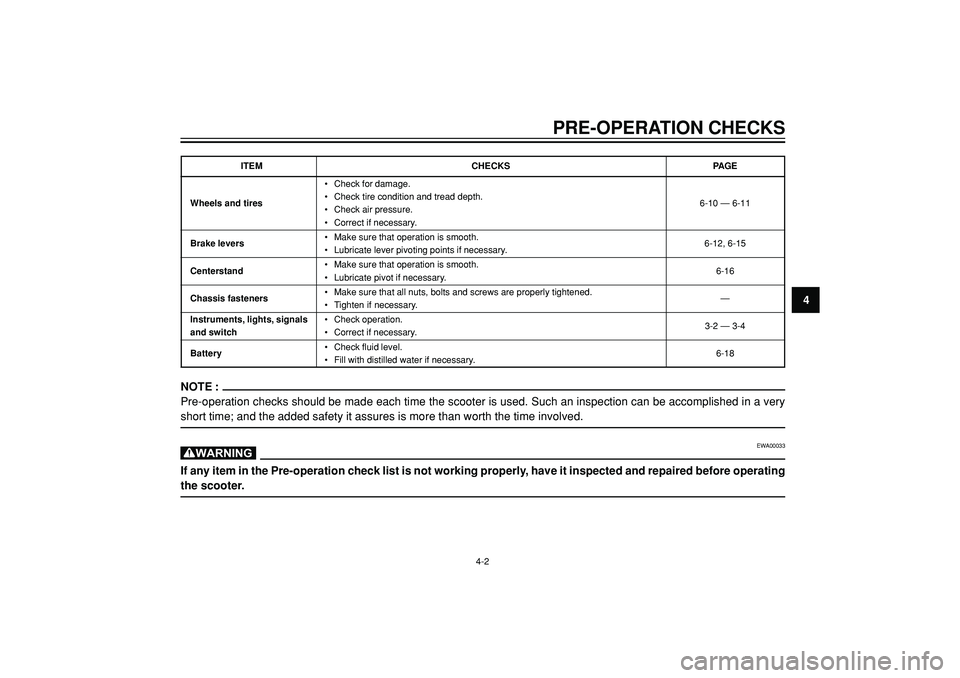
4
PRE-OPERATION CHECKS
NOTE :
Pre-operation checks should be made each time the scooter is used. Such an inspection can be accomplished in a very
short time; and the added safety it assures is more than worth the time involved.
EWA00033
If any item in the Pre-operation check list is not working properly, have it inspected and repaired before operating
the scooter.
ITEM CHECKS PAGE
•Check for damage.
Wheels and tires•Check tire condition and tread depth.
6-10 — 6-11
•Check air pressure.
•Correct if necessary.
Brake levers•Make sure that operation is smooth.
6-12, 6-15
•Lubricate lever pivoting points if necessary.
Centerstand•Make sure that operation is smooth.
6-16
•Lubricate pivot if necessary.
Chassis fasteners•Make sure that all nuts, bolts and screws are properly tightened.
—
•Tighten if necessary.
Instruments, lights, signals•Check operation.
3-2 — 3-4
and switch•Correct if necessary.
Battery•Check fluid level.
6-18
•Fill with distilled water if necessary.
4-2
Page 37 of 80
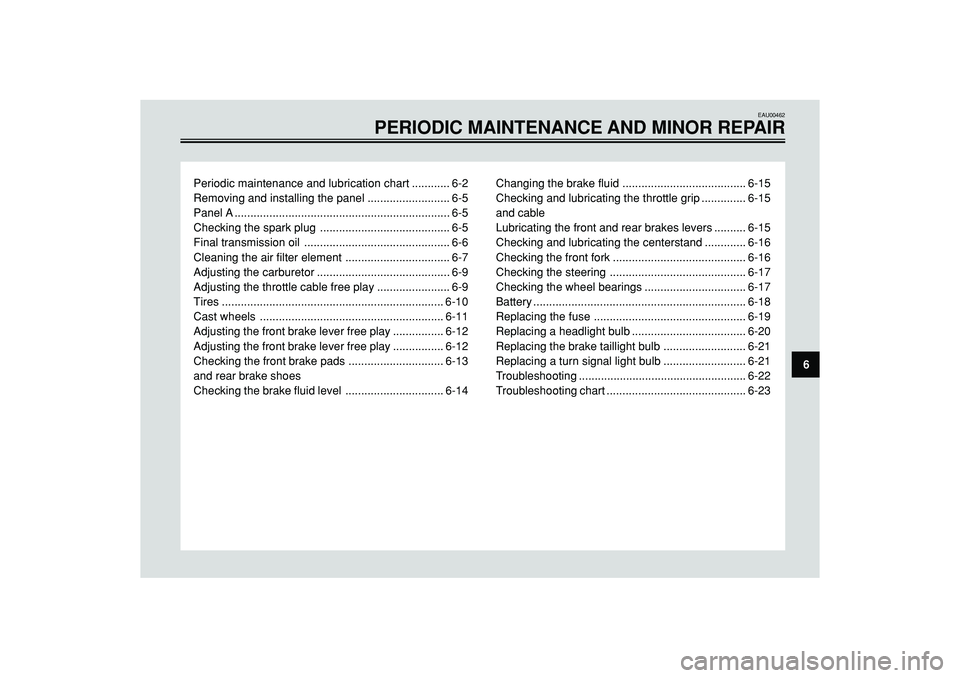
EAU00462
PERIODIC MAINTENANCE AND MINOR REPAIR
Periodic maintenance and lubrication chart ............ 6-2
Removing and installing the panel .......................... 6-5
Panel A .................................................................... 6-5
Checking the spark plug ......................................... 6-5
Final transmission oil .............................................. 6-6
Cleaning the air filter element ................................. 6-7
Adjusting the carburetor .......................................... 6-9
Adjusting the throttle cable free play ....................... 6-9
Tires ...................................................................... 6-10
Cast wheels .......................................................... 6-11
Adjusting the front brake lever free play ................ 6-12
Adjusting the front brake lever free play ................ 6-12
Checking the front brake pads .............................. 6-13
and rear brake shoes
Checking the brake fluid level ............................... 6-14
6 Changing the brake fluid ....................................... 6-15
Checking and lubricating the throttle grip .............. 6-15
and cable
Lubricating the front and rear brakes levers .......... 6-15
Checking and lubricating the centerstand ............. 6-16
Checking the front fork .......................................... 6-16
Checking the steering ........................................... 6-17
Checking the wheel bearings ................................ 6-17
Battery ................................................................... 6-18
Replacing the fuse ................................................ 6-19
Replacing a headlight bulb .................................... 6-20
Replacing the brake taillight bulb .......................... 6-21
Replacing a turn signal light bulb .......................... 6-21
Troubleshooting ..................................................... 6-22
Troubleshooting chart ............................................ 6-23
Page 39 of 80
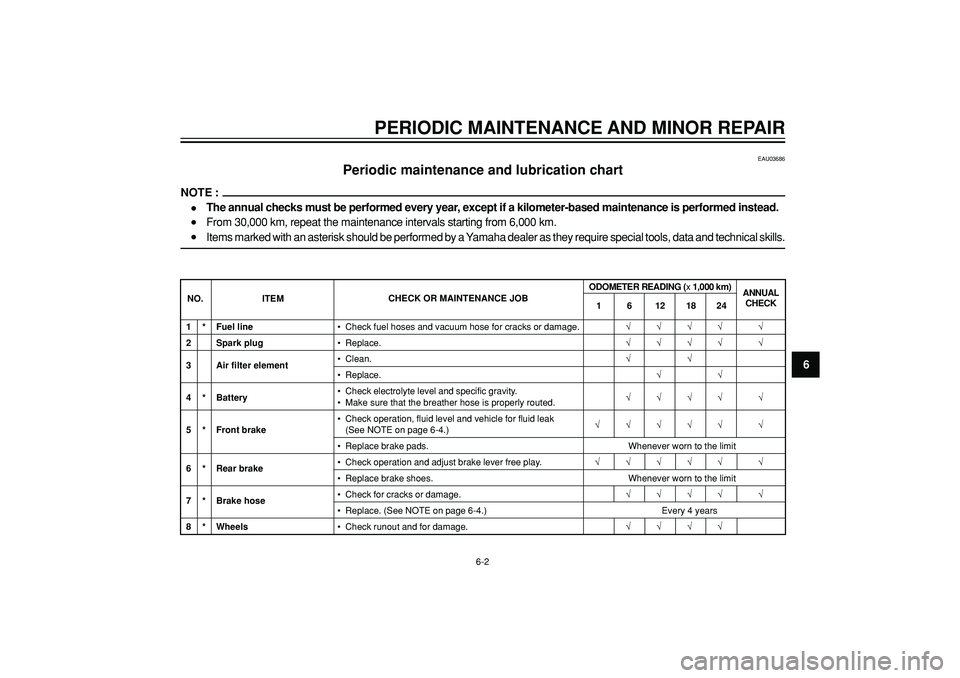
PERIODIC MAINTENANCE AND MINOR REPAIR
6
1 * Fuel line•Check fuel hoses and vacuum hose for cracks or damage.√√√√ √
2 Spark plug•Replace.√√√√ √
3 Air filter element•Clean.√√•Replace.√√
4 * Battery•Check electrolyte level and specific gravity.
√√√√ √
•Make sure that the breather hose is properly routed.
•Check operation, fluid level and vehicle for fluid leak
√√√√√ √
5 * Front brake(See NOTE on page 6-4.)
•Replace brake pads. Whenever worn to the limit
6 * Rear brake•Check operation and adjust brake lever free play.√√√√√ √•Replace brake shoes. Whenever worn to the limit
7 * Brake hose•Check for cracks or damage.√√√√ √•Replace. (See NOTE on page 6-4.) Every 4 years
8 * Wheels•Check runout and for damage.√√√√
EAU03686
Periodic maintenance and lubrication chart
NOTE :
•The annual checks must be performed every year, except if a kilometer-based maintenance is performed instead.
•From 30,000 km, repeat the maintenance intervals starting from 6,000 km.
•Items marked with an asterisk should be performed by a Yamaha dealer as they require special tools, data and technical skills.
ODOMETER READING (x 1,000 km)
NO. ITEMCHECK OR MAINTENANCE JOB
1
ANNUAL
CHECK
6121824
6-2
Page 40 of 80
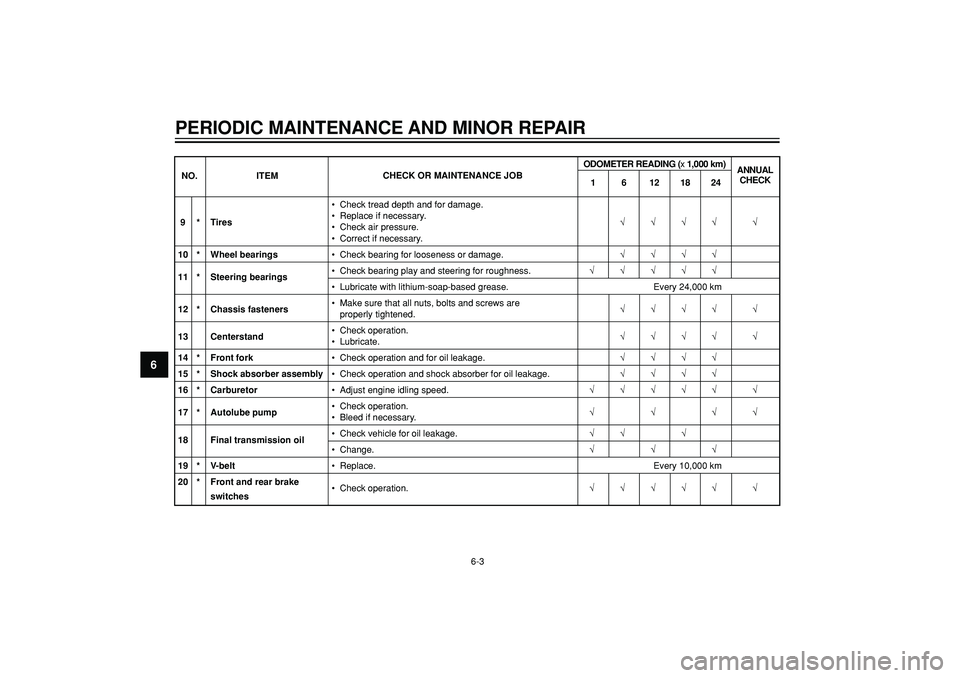
PERIODIC MAINTENANCE AND MINOR REPAIR
6
•Check tread depth and for damage.
9 * Tires•Replace if necessary.
√√√√ √
•Check air pressure.
•Correct if necessary.
10 * Wheel bearings•Check bearing for looseness or damage.√√√√
11 * Steering bearings•Check bearing play and steering for roughness.√√√√√•Lubricate with lithium-soap-based grease. Every 24,000 km
12 * Chassis fasteners•Make sure that all nuts, bolts and screws are
√√√√ √
properly tightened.
13 Centerstand•Check operation.
√√√√ √
•Lubricate.
14 * Front fork•Check operation and for oil leakage.√√√√
15 * Shock absorber assembly•Check operation and shock absorber for oil leakage.√√√√
16 * Carburetor•Adjust engine idling speed.√√√√√ √
17 * Autolube pump•Check operation.
√√√√
•Bleed if necessary.
18 Final transmission oil•Check vehicle for oil leakage.√√ √•Change.√√√
19 * V-belt•Replace. Every 10,000 km
20 * Front and rear brake
•Check operation.√√√√√ √
switches
ODOMETER READING (x 1,000 km)
NO. ITEMCHECK OR MAINTENANCE JOB
1
ANNUAL
CHECK
6121824
6-3
Page 44 of 80

PERIODIC MAINTENANCE AND MINOR REPAIR
64. Remove the oil filler cap and drain
bolt to drain the oil from the final
transmission case.
5. Install the final transmission oil
drain bolt, and then tighten it to
the specified torque.
Tightening torque:
Final transmission oil drain bolt:
17 Nm (1.7 m
•kg)
6. Add the specified amount of the
recommended final transmission
oil, and then install and tighten the
oil filler cap.Recommended final transmission oil:
See page 8-1.
Oil quantity:
0.11 L
EWA00062
•Make sure that no foreign
material enters the final trans-
mission case.
•Make sure that no oil gets on
the tire or wheel.
7. Check the final transmission case
for oil leakage. If oil is leaking,
check for the cause.
1
2
ZAUM0371
1. Oil filler cap
2. Oil drain bolt
EAUM0071
Cleaning the air filter element
The air filter element should be cleaned
at the intervals specified in the periodic
maintenance and lubrication chart.
Clean the air filter element more
frequently if you are riding in unusually
wet or dusty areas.
1. Remove the air filter case cover
by removing the screws.
1
ZAUM0372
1. Screws
6-7
Page 48 of 80

PERIODIC MAINTENANCE AND MINOR REPAIR
6Tire inspection
The tires must be checked before each
ride. If the center tread depth reaches
the specified limit, if the tire has a nail
or glass fragments in it, or if the sidewall
is cracked, have a Yamaha dealer re-
place the tire immediately.
Minimum tire tread depth
(front and rear)1.6 mm
Front
Manufacturer Size Type
MICHELIN 2 1/2 -16 42M M29S TT
Rear
Manufacturer Size Type
MICHELIN 2 3/4 -16 46M M29S TT
1
2
ZAUM0054
NOTE :
The tire tread depth limits may differ
from country to country. Always comply
with the local regulations.Tire information
This scooter is equipped with tubeless
tires.
1. Tire tread depth
2. Tire sidewall
EAU03773
Cast wheels
To maximize the performance,
durability, and safe operation of your
scooter, note the following points
regarding the specified wheels.
•The wheel rims should be
checked for cracks, bends or
warpage before each ride. If any
damage is found, have a Yamaha
dealer replace the wheel. Do not
attempt even the smallest repair
to the wheel. A deformed or
cracked wheel must be replaced.
•The wheel should be balanced
whenever either the tire or wheel
has been changed or replaced. An
unbalanced wheel can result in
poor performance, adverse
handling characteristics, and a
shortened tire life.
•Ride at moderate speeds after
changing a tire since the tire surface
must first be "broken in" for it to
develop its optimal characteristics.
6-11
Page 54 of 80

PERIODIC MAINTENANCE AND MINOR REPAIR
6
EAU01144
Checking the wheel bearings
The front and rear wheel bearings must
be checked at the intervals specified in
the periodic maintenance and
lubrication chart. If there is play in the
wheel hub or if the wheel does not turn
smoothly, have a Yamaha dealer check
the wheel bearings.
6-17
2. Hold the lower ends of the front
fork legs and try to move them
forward and backward. If any free
play can be felt, have a Yamaha
dealer check or repair the
steering.
ZAUM0379
EAU00794
Checking the steering
Worn or loose steering bearings may
cause danger. Therefore, the operation
of the steering must be checked as
follows at the intervals specified in the
periodic maintenance and lubrication
chart.
1. Place a stand under the engine
to raise the front wheel off the
ground.
EW000115
Securely support the scooter so that
there is no danger of it falling over.
Page 62 of 80
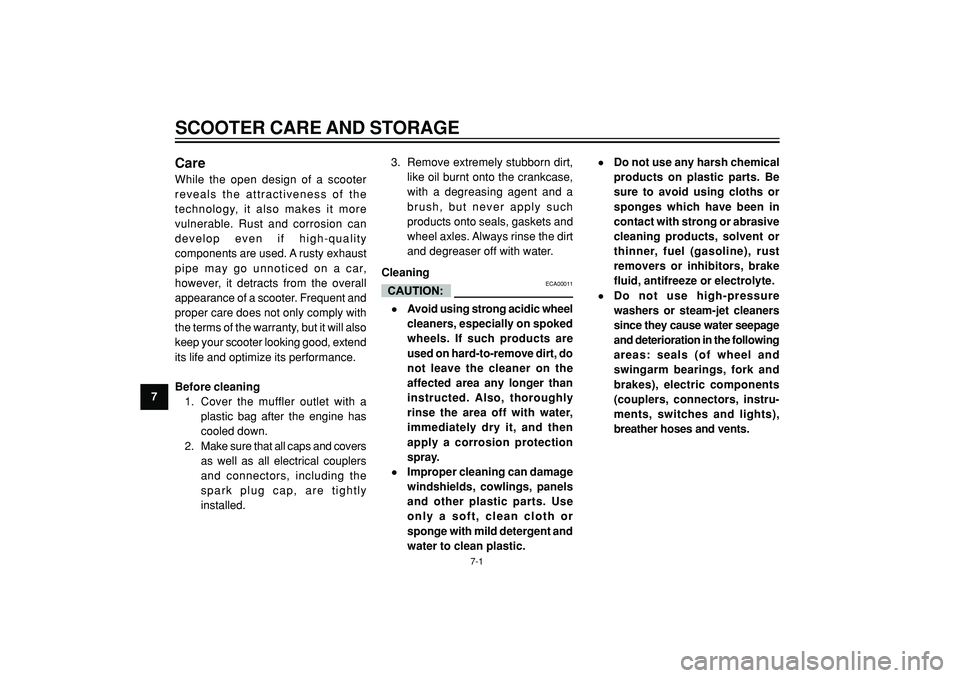
SCOOTER CARE AND STORAGE
7
Care
While the open design of a scooter
reveals the attractiveness of the
technology, it also makes it more
vulnerable. Rust and corrosion can
develop even if high-quality
components are used. A rusty exhaust
pipe may go unnoticed on a car,
however, it detracts from the overall
appearance of a scooter. Frequent and
proper care does not only comply with
the terms of the warranty, but it will also
keep your scooter looking good, extend
its life and optimize its performance.
Before cleaning
1. Cover the muffler outlet with a
plastic bag after the engine has
cooled down.
2. Make sure that all caps and covers
as well as all electrical couplers
and connectors, including the
spark plug cap, are tightly
installed.3. Remove extremely stubborn dirt,
like oil burnt onto the crankcase,
with a degreasing agent and a
brush, but never apply such
products onto seals, gaskets and
wheel axles. Always rinse the dirt
and degreaser off with water.
Cleaning
ECA00011
•Avoid using strong acidic wheel
cleaners, especially on spoked
wheels. If such products are
used on hard-to-remove dirt, do
not leave the cleaner on the
affected area any longer than
instructed. Also, thoroughly
rinse the area off with water,
immediately dry it, and then
apply a corrosion protection
spray.
•Improper cleaning can damage
windshields, cowlings, panels
and other plastic parts. Use
only a soft, clean cloth or
sponge with mild detergent and
water to clean plastic.
•Do not use any harsh chemical
products on plastic parts. Be
sure to avoid using cloths or
sponges which have been in
contact with strong or abrasive
cleaning products, solvent or
thinner, fuel (gasoline), rust
removers or inhibitors, brake
fluid, antifreeze or electrolyte.
•Do not use high-pressure
washers or steam-jet cleaners
since they cause water seepage
and deterioration in the following
areas: seals (of wheel and
swingarm bearings, fork and
brakes), electric components
(couplers, connectors, instru-
ments, switches and lights),
breather hoses and vents.
7-1
Page 65 of 80

SCOOTER CARE AND STORAGE
7 a. Remove the spark plug cap
and spark plug.
b. Pour a teaspoonful of engine
oil into the spark plug bore.
c. Install the spark plug cap onto
the spark plug, and then place
the spark plug on the cylinder
head so that the electrodes are
grounded. (This will limit
sparking during the next step.)
d. Turn the engine over several
times with the starter. (This will
coat the cylinder wall with oil.)
e. Remove the spark plug cap
from the spark plug, and then
install the spark plug and the
spark plug cap.
EWA00003
To prevent damage or injury from
sparking, make sure to ground the
spark plug electrodes while turning
the engine over.
5. Lubricate all control cables and
the pivoting points of all levers and
pedals as well as of the sidestand/
centerstand.
6. Check and, if necessary, correct
the tire air pressure, and then lift
the scooter so that both of its
wheels are off the ground.
Alternatively, turn the wheels a
little every month in order to
prevent the tires from becoming
degraded in one spot.
7. Cover the muffler outlet with a
plastic bag to prevent moisture
from entering it.
8. Remove the battery and fully
charge it. Store it in a cool, dry
place and charge it once a month.
Do not store the battery in an
excessively cold or warm place
(less than 0 °C or more than 30
°C). For more information on
storing the battery, see page 6-
18.
NOTE :
Make any necessary repairs before
storing the scooter.
7-4
Page 68 of 80

SPECIFICATIONS
8
Model YH50
Dimensions:
Overall length 1.940 mm
Overall width 685 mm
Overall height 1.105 mm
Seat height 765 mm
Wheelbase 1.294 mm
Minimum ground clearance 125 mm
Minimum turning radius 1.800 mm
Weight:
Wet (with oil and a full fuel tank) 78 kg
Engine:
Engine type Air cooled, 2 strokes
Cylinder arrangement Single cylinder, horizontal
Displacement 49.2 cm3
Bore x stroke 40.0 x 39.2
Compression ratio 7.25:1
Starting system type Electric and kick starter
Lubrication system Separate lubrication
(Autolube)
Engine oil:
Type Yamalube 2
or 2 strokes engine oil
Classification Jaso FC ou ISO EG-C, EG-D
Capacity 1.3 LTransmission oil:
Type SAE 10W30 type SE
Capacity
Périodic oil change 0.11L
Total amount 0.13L
Air filter type:Wet type element
Fuel:
Recommended fuel Regular unleaded gasoline
(RON 91 mini)
Fuel tank capacity 7L
Carburetor:
Type / quantity PY-12
Manufacturer GURTNER
Spark plug:
Type / Manufacturer BR8HS / NGK
Spark plug gap 0.6—0.7 mm
Clutch type:Dry, centrifugal automatic
Transmission:
Primary reduction system Helical gear
Primary reduction ratio 52/13 (4.000)
Secondary reduction system Spur gear
Secondary reduction ratio 45/12 (3.750)
Transmission type V-belt automatic
Operation Centrifugal automatic type
8-1
Specifications